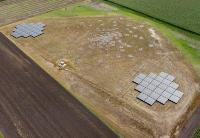LOFAR to boost solar research

LOFAR
27 September 2010
The first major radio telescope to be built in Britain for decades will provide the best view yet of the Sun’s outer atmosphere according to scientists at Aberystwyth University.
LOFAR, or Low Frequency Array, was officially opened by Dame Jocelyn Bell Burnell at a ceremony at the Science and Technologies Facilities Council’s Chilbolton Observatory in Hampshire on Monday 20 September.
Aberystwyth University is one of 22 UK Universities who have collaborated on the development of LOFAR.
The telescope, which is part of the European LOFAR project will ‘listen’ to the Universe at FM frequencies, helping astronomers detect when the first stars in the Universe were formed, to reveal more about how the Universe evolved and may well help answer questions such as “Are we alone?” and “how did black holes grow in our universe?”
Dr. Andy Breen from the Institute of Maths and Physics leads the interplanetary section of the Solar and Space Environment science area within LOFAR. He said; “LOFAR will give us the best view yet of the Sun's outer atmosphere and solar wind, and how it impacts on the space environments of planets. The Chilbolton station gives us the wide separation between sites that we need for solar wind studies – I'm very much looking forward to seeing the first data from the new station.
“The involvement of Aberystwyth and Cardiff Universities in LOFAR puts Wales at the centre of the most exciting developments in space science and astronomy,” he added.
During the ceremony, guests were able to observe a pulsar in real time using the Chilbolton station; Dame Jocelyn Bell Burnell discovered the first radio pulsars, so it was most appropriate for her to perform the opening. Professor Rob Fender of the University of Southampton, Principal Investigator of the LOFAR UK project said "The most amazing thing is that these small dipole antennas can pick up faint radio signals from over 10 billion years ago, when the universe was a fraction of its current size, and that this signal can be mapped over the entire sky by the telescope without a single moving part."
LOFAR is a European project which when complete, will see 5000 separate antennas grouped into 'stations' all over Europe, including the Chilbolton Observatory to form the world's largest and most sensitive radio telescope. LOFAR works at the lowest frequencies accessible from Earth which, combined with the latest in high-tech computing, allows wide areas of the sky to be surveyed opening up new possibilities for astronomers.
The installation of the 96 telescope radio antennas that make up the Chilbolton station was completed by scientists from a consortium of universities involving a large number of students. Derek McKay-Bukowski, Project Manager at LOFAR Chilbolton for STFC/SEPnet, said; “The team working on the project have been great. We've had the best of UK scientists and engineers, but also lots of university students too. For them, it has been an amazing learning experience."
The opening ceremony at Chilbolton Observatory preceded an event at INTECH Science Centre, Winchester, where guests were invited to hear a series of presentations from members of the LOFAR community, STFC and ASTRON (The Netherlands Foundation for Research in Astronomy) followed by a live Planetarium show highlighting the LOFAR capabilities presented by Dr Jenny Shipway, INTECH Planetarium Manager.
At the INTECH event Professor Mike Garrett, General Director, ASTRON said “The International LOFAR Telescope is opening up a new window on the universe - there is a lot of excitement about just what we are going to discover. The LOFAR station in Chilbolton, will double the level of detail we will be able to see in the images LOFAR will produce. It's also fantastic to have the UK astronomical community fully onboard - they will help ensure that this transformational new telescope is fully exploited scientifically - we're looking forward to the first results”.
LOFAR UK is funded through a collaboration of UK universities with the SEPnet consortium and the UK Science and Technologies Facilities Council which includes RAL Space at STFC’s Rutherford Appleton Laboratory, STFC’s UK Astronomy Technology Centre and STFC’s Chilbolton Observatory.
The universities involved include Aberystwyth, Birmingham, Cambridge, Cardiff, Durham, Edinburgh, Glasgow, Hertfordshire, Leicester, Liverpool John Moores, Kent, Manchester, Newcastle, Nottingham, Open University, Oxford, Portsmouth, Queen Mary University of London, Sheffield, Southampton, Sussex, and University College London.
AU17610



